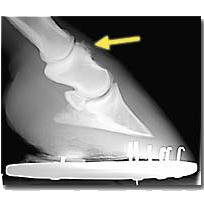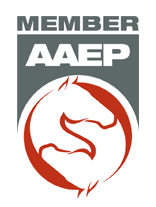RingboneBy Dr Jennifer Wickline
Ringbone is a bone growth of the pastern or coffin joint of horses. In severe cases, the growth actually encircles the bone which is where the name ringbone comes from. Two types of ringbone exist: high ringbone can be seen as a firm swelling on the pastern, while a bony growth around the coffin joint is known as low ringbone and is generally less noticeable to the naked eye. Ringbone is most commonly observed in mature horses in intense work programs, but it can also be brought about by trauma. It is caused by instability within the joint generally resulting from an injury to surrounding tendons and ligaments. When a joint is unstable, or stressed beyond its limit, new bone is produced in an attempt to stabilize it and the result is oftentimes ringbone. Poor conformation and inadequate shoeing can predispose a horse to ringbone because unbalanced conformation or shoeing creates uneven pressure and thus added stress on the coffin and pastern joints. A horse with ringbone will have limited mobility to the pastern joint, and can be lame to varying degrees depending on the severity and location of the bony proliferation. There are many options available for treatment such as therapy for pain management with a medication such as bute. Injecting the pastern or coffin joint with steroids and some form of hyaluronic acid (HA- a synthetic synovial fluid replacement) can often help alleviate lameness for a period of time. IRAP therapy, a procedure where anti-inflammatory properties of a patientís own blood are harvested, is a fairly new way to manage the progression of this condition. In cases of high ringbone that have progressed, or bony growth is aggressive and near the joint, medical or surgical fusion of the joint is an option. Surgical fusion involves applying a bone plate at the front of the joint, and medical arthrodesis involves injecting medical-grade alcohol into the joint. Arthrodesis is not a viable option for patients with low ringbone because the coffin joint is a high motion joint and does a lot of bending and flexing, not to mention it is difficult to access surgically because of its location. Since the pastern joint is a low motion joint, fusing this joint affects the horseís natural movement less than other joints. The prognosis for horses diagnosed with ringbone varies on the degree of bony proliferation and response to initial therapy. Many horses with ringbone can continue their work, although commonly at a lower level than before. Itís important to discuss with your veterinarian all the treatment options and decide what is best for your horse. Call us at Equine Veterinary Services (972.524.7075) to find out more about ringbone and what type of treatment is best for your horse. Equine Veterinary Services
|


©2024 Website Design and Photos by Jim Arnold,
Carroll Brown Arnold and Austria C. Arnold
